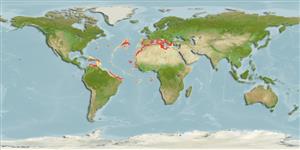Common names from other countries
Classification / Names / Names
Namen | Synonyme | Catalog of Fishes (gen., sp.) | ITIS | CoL | WoRMS
Environment: milieu / climate zone / depth range / distribution range
Ökologie
; tiefenbereich 36 - 1935 m (Ref. 1821). Tropical
Western Atlantic, Caribbean: USA and Brazil. Eastern Atlantic: North Africa and Gulf of Guinea. Tropical to subtropical climates.
Length at first maturity / Size / Gewicht / Alter
Maturity: Lm ? range ? - ? cm Max length : 5.0 cm SHL Männchen/unbestimmt; (Ref. 3441)
Shell slightly curved, slender, white. Low primary ribs (15-20). Crossed by transversal lines giving an irregular aspect to the whole surface. Apex is simple or V- or U-shaped notch on convex side. Apical, oral sections subcircular.
Minimum depth from Ref. 111279. Infaunal (Ref. 111279).
Life cycle and mating behavior
Geschlechtsreife | Fortpflanzung | Ablaichen | Eier | Fecundity | Larven
Members of the class Scaphopoda are gonochoric. Fertilization occurs in the mantle cavity. Life cycle: Eggs hatch into free-swimming lecithotrophic trochophore larvae, succeeded by shelled veligers.
Steiner, G. and A.R. Kabat. 2004. (Ref. 1821)
IUCN Rote Liste Status (Ref. 130435)
CITES Status (Ref. 108899)
Not Evaluated
Not Evaluated
Nutzung durch Menschen
| FishSource |
Tools
Mehr Information
Alter/GrößeWachstumLänge-GewichtLänge-LängeMorphologieLarvenDichte
Internet Quellen
Estimates based on models
Preferred temperature
(Ref.
115969): 4.9 - 13.8, mean 11.4 (based on 231 cells).
Verwundbarkeit
Low vulnerability (10 of 100).
Preiskategorie
Unknown.
